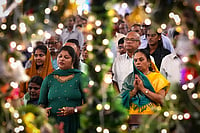One of the truly unfortunate misconceptions of architectural book publishing relies on the misguided belief that the coffee-table format is itself an indication of good architecture. Books on monuments, forts, palaces, castles have to be lavish colour spreads of enormous wide-angled photographs that leave the reader—or rather the viewer—groping in breathless ecstasy. Such books generally rely on photography for their message, which are often accompanied by scant and irrelevant text. Meant mainly for the foreign tourist, or the housewife matching book-cover to sofa, text doesn’t matter. The literary value of such books is suspect; more so, since their monetary value is usually in dollars. The cheap paperback, on the other hand, is meant for subjects like low-cost housing or the typology of rural latrines—ideas of such routine utility, they have no shelf value—and is ruthlessly discarded. By contrast, these books tend to be more informative, and—unlike their more well-to-do cousins in the drawing room—do not require to be insured against theft, fire or coffee stains.
But sometimes, there appears something that gives the big pictorial spread real value. Vikram Lall’s The Golden Lands is one such brilliant endeavour. A serious arrangement of valuable documentary material structured in a way that gives equal weight to text, drawing and photograph. As the historical text unfolds, the reader is drawn into the Buddhist archaeology of places as diverse—and connected—as Thailand, Vietnam, Indonesia and other countries of the Far East.
Lall has planned the work as a series. This, the first, introduces the reader to Buddhism’s earliest and most monumental of structures in Southeast Asia, including some of the most spectacular architecture of Borobodur in Indonesia, and the great walled enclosures and mountainous temple complexes of Cambodia. Temple layout in photos, plans, sectional views and aerial drawings appear alongside and convey a message that is scholarly in research and entirely architectural in presentation.
That the book’s organisation goes from history to architectural characteristics and finally to details of selected complexes is maybe too simplistic an arrangement for a subject of such religious complexity; but perhaps this seemed the only logical way to give due importance to all the projects and regions covered. Throughout the enormous historical reach, Lall remains true to the professional call—elaborating with scholarship on drawings rarely seen on archaeological studies, with photography that fittingly adds the daily and seasonal variations of light and texture, and the ancient patina of time to the hard-edged geometric line work. Shadowed three-dimensioned drawings cut away to the space inside. The sequences not only enthral the onlooker, but engage the eye with their lavish complimentarity.
The book is as detailed and thorough as the various temples, stupas and monastic precints it covers. Lall is one of the rare architects with the gift of documentation, not in the dry tone of a researcher spewing collected material, but a master-chef who knows his ingredients and is as fascinated with their combination as the tastes of his sumptuous meal. The book is still an architectural work in progress; the next series covers India, China and Japan. Perhaps a long wait, but entirely worth it.






















